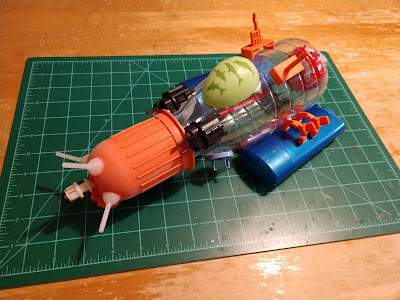Back in April 2021, I assembled and painted one of these models to test out a color scheme suitable for the whole box. That test worked well, but I had a couple of other ideas that I wanted to try before I started painting in bulk. Other things caught my attention and, with no immediate need for the figures, I shelved the project.
 |
| "It's been almost a year since this blogger made progress on this project?" "Time flies." |
I recently pulled the box back out with a few goals in mind:
- Getting more time working on multi-part 28mm scale plastic models. I'm in need of miniatures suitable as "Psychos" for my Five Parsecs From Home campaign. The strongest candidates in my current collection are box of Necromunda Eschers. However, I'm reluctant to start on them without more experience with assembling plastic miniatures.
- Testing out a couple of military color schemes for the Wargames Factory Shock Troopers box. They will all likely end up in my Five Parsecs From Home campaign at some point, so moving forward with this project serves that end as well.
- Developing techniques suitable for speed painting armies. I'm used to painting miniatures individually, but that approach is impractical for groups of thematically related figures. Projects like this, the Reaper Bones Zombies, and the Reaper Bones Nova Corp are helping to build up my experience in that area.
I switched from my usual Gorilla Super Glue to plastic cement for this product. This gave me more time to get the arms in the desired position while everything set. I'm planning on using the same stuff on the Eschers based on my experience here. I did use super glue in one area - attaching the models to the metal washers I used as bases.
 |
| They seem to be holding together well. |
Thoughts on Flame Throwers
I understand that historical soldiers using flame throwers had a lower than average life expectancy in combat. A flame thrower is a relatively short ranged weapon with limited ammunition, requiring the operator to close with the target. The discharge of a flame thrower tends to attract attention and rifle rounds. While the risk of taking a round in the fuel tank is overstated, drawing fire is generally unhealthy. I kept these notions in mind while picking out bits for the model.
Olive Drab Flame Trooper - Assembly
The fuel tank on this particular flame thrower design is tiny. Given the limited ammunition, it made sense to issue this trooper a sidearm. A shotgun would have been my preference, but I made do with one of the holstered pistols in the kit. I also added a water canteen since operating a flame thrower has got to be at least as hot as grilling a meal for the family in Texas on Independence Day. The choice of head was based on which one appeared to offer the best protection from both heat and small arms fire.
 |
| Not much ammunition in that tank, I imagine. |
Olive Drab Flame Trooper - Paint Scheme
The sight of assembled trooper evoked far away memories of plastic green army men carrying M2 flame throwers battling it out in the back yard. Inspired, I settled on an olive color scheme.
- Primer coat: Krylon Fusion All-In-One Matte Black. Sprayed for full coverage.
- Base coat: Krylon Camouflage Ultra-Flat Olive. Sprayed in a zenithal pattern.
- Highlight layer: Reaper 09177 Camouflage Green. Dry brushed on the upper surfaces.
- Gray areas (weapon, mask, boots): Mix of Citadel Colour Codex Grey with a little Chaos Black.
- Wash coats: Army Painter Dark Tone and Strong Tone Quickshade Inks. Each layer was applied separately and allowed to dry completely before the next.
Basically, I wanted to use the pointing arm. Pairing it with another arm holding a pistol and a dagger fit the theme of some kinda unit leader. The choice of a head came down to the one wearing a garrison cap and the one with tentacles. I didn't spent long making my decision. Even if I eventually get rid of rest of the box, I'll be keeping the tentacled heads around in my bits collection for as long as they last.
 |
| These came from an extra sprue, so I have a box of eighteen to go. |
Khaki NCO - Paint Scheme
The steps using spray coats substituted Krylon Camouflage Ultra-Flat Khaki for the Olive, but were otherwise identical to the Olive Drab Flame Trooper. The gray areas used the same mix of Citadel Colour Codex Grey with a little Chaos Black. The wash coats were also used the same products as the Olive Drab Flame Trooper.
- Highlight layer: Reaper 09292 Bathalian Chitin. Dry brushed on the upper surfaces.
- Head: Reaper 09233 Bright Skin. This color is a little too pink to be a realistic skin tone for a human, but works fine in this case.
The assembled plastic models were glued to one inch steel fender washers before painting. I used the same techniques for texturing the base as I do for Reaper Bones miniatures.
 |
| Decisions, decisions. |
These turned out well. Which leaves me with a problem. I can't decide which paint scheme to go with for the box! Maybe I can divide up the remaining troopers into teams, each in a different color? I'll have to think it over.














